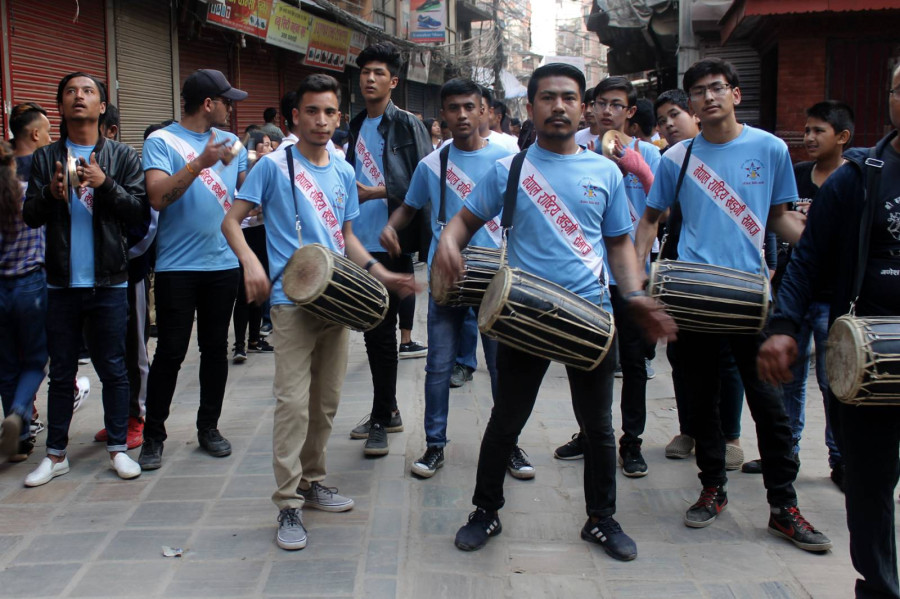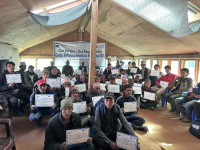Culture & Lifestyle
The slow fading of the nayakhin baja
The treble of the nayakhin, part of the nau baja ensemble, echoes the spirit of Newa celebration. But over the years, the instrument has lost much of its essence.
Srizu Bajracharya
The sound of the nayakhin baja is present in almost every Newa celebration or festival in the Valley—in Gunla, in the Bunga Dyah Jatra, Indra Jatra, Paha Chare, sometimes, even during the morning bhajan sessions in the old core areas of the Valley. It’s a familiar sound, one that many in Kathmandu have grown up listening to, yet not many notice its distinctiveness.
When Ratna Lal Shahi starts playing the nayakhin baja, his eyes immediately close as he immerses himself in the sound he fills the room with. His left hand, clasping a stick, rhythmically hits the barrel while his right palm pounds on it. Shahi, who has been teaching nayakhin for over 40 years, knows the rhythm like the back of his hands. But today he is worried that people will never understand this rhythm, a sound he deeply endears.
“It’s an often overlooked musical instrument. In all these years of teaching, I have never felt the honesty of my students to learn this musical instrument for musical pursuit itself,” he says. “Of course, they play wonderfully, but only for occasions, not for its music.”
The nayakhin baja, which is part of the nau baja ensemble and is identified as the musical instrument of the Naya Newa community, the Khadgis, hasn’t aged gracefully. It is considered an endangered musical instrument even though it gives life to many festivals in the Valley, because over the years, people have also slowly abandoned many traditional rhythms.
At Bhaktapur, the musical instrument’s practice has already died out. And even with initiatives to conserve the baja from getting defunct, not many people have explored or experimented with the musical instrument for creative pursuit. And as a result, its music has not evolved with time, and even today, not many know much about this instrument.
“It may be because learning nayakhin baja is different from learning other bajas,” says Shahi. “There are rules as to when and where you can play it as its sounds can really influence people’s lives,” he says. Playing the baja also requires one to adhere to religious rituals such as dhyahlaygu, an invocation of the deity nasadhyah, a form of lord Shiva.
According to Shahi, some particular tunes of the instrument can even call upon rain, or rage a fire. The music produced from the instrument has the power to boost spirits and even swathe people in grief, he says. The nayakhin baja is also used to play seeh baja, the music for the dead, which is used in death processions.
“The music is also used to please deities and you will see its representation in the images of deities like Nateshwori,” he says, showing an image of a deity who is also holding the two-headed cylindrical instrument. “Some of the baja’s taal (beat) also represents different seasons,” he says.
The baja was also used to call upon people’s attention to inform them about an event or an issue, says Shahi. And as the lead instrument of an ensemble, the instrument marshals the path of processions during festivals.
Today, to encourage the youths’ participation with the traditional instrument, many community organisations and institutions have also been teaching nayakhin baja. In 2018, in hopes of systemising the training of nayakhin baja, the Nepal Rastriya Khadgi Samaj had also started searching for nayakhin gurus, teachers to formally train students in an organised way.
“The main idea was to bring uniformity to the baja we would play in the jatra and to conserve and aware people about the musical instrument,” says Pratik Khadgi, a member of the committee who oversees the conservation of nayakhin baja. The organisation has been providing monthly training of the musical instrument in Patan, Kathmandu, Bhaktapur and even outside the Valley.
“I believe once people are aware of the instrument and its importance, we can then begin to explore its music in other forms and right now, we are just building that foundation,” he says.
But previously, training of nayakhin baja was limited to a specific month and only to people from the Naya community. “Teachers would only teach during the month of Yanla, (the 11th month in the lunar calendar) and only to people from the community due to traditional belief of its learning specificity,” says Khadgi.
“It was probably one of the reasons behind its downfall, as when people from the caste group themselves stopped playing the instrument, there was no one to carry the music forward,” says Season Maharjan, a member of On Acid, a Nepali band. Maharjan had learned to play nayakhin at Kathmandu University Department of Music.
In an effort to help revive the practice of the instrument in Bhaktapur, a few years ago, during his college, Maharjan participated in a procession called Swa Bigu, a ritual of offering flowers in temples during Gai Jatra.
“We were told at the time there was only one person who plays the instrument in Bhaktapur. And so, we went for a musical procession around temples as they used to do in the old days. That tradition had stopped for many years and what we were doing at the time was more an initiative to aware people and I think we were able to do that,” he says.
But part of the reason why the practice vanished was because of how the caste group was oppressed, he says, referring to Gert-Matthias Wegner's book Naykhi Baja of Bhaktapur. The book studies the music’s practice in Bhaktapur and how the traditional baja ceased being practised in the community.
“The community who plays this musical instrument come from the butcher caste and they weren’t allowed to play other musical instruments that were given more honour. And so, people slowly resolved to not playing the instrument,” says Maharjan.
Khadgi, however, says more than caste oppression, it was a lack of teachers and the instrument itself that caused fewer people to pick up the instrument. "The government too didn't support this cultural learning and over the years this tradition of learning the music was broken," he says.
But according to Ratna Lal Shahi, the trend of playing nayakhin had started to dwindle as early as the 1930s. “Our lifestyle was changing, and our priorities too, we had to focus more on earning a living and people were getting busy and in those days, people didn’t understand arts and music, and so the music never evolved,” he says. Shahi himself had learned the baja by listening and copying his seniors instead of being trained to play the instrument.
“We were not formally trained, we just learned by seeing and doing things. But even though things have changed today, and learning music has become easier, I don’t think so people have taken interest in learning nayakhin baja,” he says.
Many students who now take an interest in learning the baja only do so to participate in festivals. “It’s more a part of engaging with our culture and continuing traditions but the music has not evolved,” says Shahi.
Although bands like Upendra and Friends and Night have used the instrument and experimented with its music, not many people have explored the nayakhin baja in contemporary music or pursued the music professionally.
In 2016, Upendra and Friends had released an instrumental album, titled Rhythmic Delight, which experimented the sounds of the nayakhin with a western instrument. “It was called the Rhythm of Nayakhin and we just wanted to explore the fusion between an eastern and western instrument,” says Roshan Maharjan, a band member of Upendra and Friends who had played the nayakhin in the instrumental.
“It’s the age of fusion, and so to really build people’s interest in this baja we need more people to experiment with its music,” says Kaushalya Shahi, a former student of Shahi and his daughter. “But that hasn’t happened enough and so the traction of people following the instrument professionally has not seen any growth,” she says.
But conserving the baja without exploring different possibilities is not a functional way of ensuring that the music will thrive in the future. For any music to thrive, there needs to be development and growth, says Maharjan. “And that is only possible if we are willing to push our boundaries and explore the music professionally,” he says.
“If we are to conserve this musical instrument, we have to transcend communities and practices,” adds Maharjan. “Only when we start exploring our traditional baja, not just in terms of continuing traditions but with the sincerity of expanding its horizon, we will also be able to give identity and flavour to the music we are creating.”




 15.12°C Kathmandu
15.12°C Kathmandu















